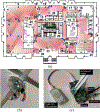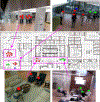Indoor Group Identification and Localization Using Privacy-Preserving Edge Computing Distributed Camera Network
- PMID: 38406564
- PMCID: PMC10885707
- DOI: 10.1109/jispin.2024.3354248
Indoor Group Identification and Localization Using Privacy-Preserving Edge Computing Distributed Camera Network
Abstract
Social interaction behaviors change as a result of both physical and psychiatric problems, and it is important to identify subtle changes in group activity engagements for monitoring the mental health of patients in clinics. This work proposes a system to identify when and where group formations occur in an approximately 1700 m2 therapeutic built environment using a distributed edge-computing camera network. The proposed method can localize group formations when provided with noisy positions and orientations of individuals, estimated from sparsely distributed multiview cameras, which run a lightweight multiperson 2-D pose detection model. Our group identification method demonstrated an F1 score of up to 90% with a mean absolute error of 1.25 m for group localization on our benchmark dataset. The dataset consisted of seven subjects walking, sitting, and conversing for 35 min in groups of various sizes ranging from 2 to 7 subjects. The proposed system is low-cost and scalable to any ordinary building to transform the indoor space into a smart environment using edge computing systems. We expect the proposed system to enhance existing therapeutic units for passively monitoring the social behaviors of patients when implementing real-time interventions.
Keywords: Cameras; group position detection; group position estimation; pose estimation.
Figures








Similar articles
-
Feasibility of assessing cognitive impairment via distributed camera network and privacy-preserving edge computing.Alzheimers Dement (Amst). 2025 Feb 24;17(1):e70085. doi: 10.1002/dad2.70085. eCollection 2025 Jan-Mar. Alzheimers Dement (Amst). 2025. PMID: 39996034 Free PMC article.
-
Graph Trilateration for Indoor Localization in Sparsely Distributed Edge Computing Devices in Complex Environments Using Bluetooth Technology.Sensors (Basel). 2023 Nov 30;23(23):9517. doi: 10.3390/s23239517. Sensors (Basel). 2023. PMID: 38067890 Free PMC article.
-
Smart Artificial Markers for Accurate Visual Mapping and Localization.Sensors (Basel). 2021 Jan 18;21(2):625. doi: 10.3390/s21020625. Sensors (Basel). 2021. PMID: 33477398 Free PMC article.
-
A survey of security, privacy and trust issues in vehicular computation offloading and their solutions using blockchain.Open Res Eur. 2023 Oct 25;3:110. doi: 10.12688/openreseurope.16189.2. eCollection 2023. Open Res Eur. 2023. PMID: 37969246 Free PMC article. Review.
-
Federated Learning in Edge Computing: A Systematic Survey.Sensors (Basel). 2022 Jan 7;22(2):450. doi: 10.3390/s22020450. Sensors (Basel). 2022. PMID: 35062410 Free PMC article. Review.
Cited by
-
Feasibility of assessing cognitive impairment via distributed camera network and privacy-preserving edge computing.Alzheimers Dement (Amst). 2025 Feb 24;17(1):e70085. doi: 10.1002/dad2.70085. eCollection 2025 Jan-Mar. Alzheimers Dement (Amst). 2025. PMID: 39996034 Free PMC article.
References
-
- Mechakra-Tahiri S, Zunzunegui MV, Préville M, and Dubé M, “Social relationships and depression among people 65 years and over living in rural and urban areas of quebec,” Int. J. Geriatr. Psychiatry, vol. 24, no. 11, pp. 1226–1236, 2009. - PubMed
-
- Deepa V, Baber H, Shukla B, Sujatha R, and Khan D, “Does lack of social interaction act as a barrier to effectiveness in work from home? COVID-19 and gender,” J. Organizational Effectiveness: People Perform, vol. 10, no. 1, pp. 94–111, 2023.
-
- Ware S et al., “Automatic depression screening using social interaction data on smartphones,” Smart Health, vol. 26, 2022, Art. no. 100356. [Online]. Available: https://www.sciencedirect.com/science/article/pii/S2352648322000903
-
- Fulford D et al., “Smartphone sensing of social interactions in people with and without schizophrenia,” J. Psychiatr. Res, vol. 137, pp. 613–620, 2021. [Online]. Available: https://www.sciencedirect.com/science/article/pii/S002239562031058X - PMC - PubMed
Grants and funding
LinkOut - more resources
Full Text Sources
